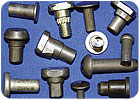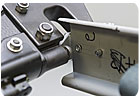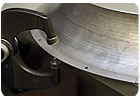Pneumatic and hydraulic rivet squeezers install solid rivets in a wide range of structural assemblies.


Sometimes, a good, hard squeeze is better than a rap on the head or a pull on the tail-at least for installing certain kinds of rivets.
Tubular and semitubular rivets are typically installed with a pedestal-mounted impact riveter. As the name implies, an impact riveter upsets the rivet with one quick, powerful blow from the ram. In contrast, a blind rivet consists of a headed, hollow rivet body and a headed, solid mandrel, or tail. The riveter grips the mandrel and pulls it through the rivet body, causing the body to expand and forcing the materials together.
Solid rivets require a different approach. Unlike tubular, semitubular and blind rivets, a solid rivet doesn’t have a hollow section that makes it easy to upset. It’s a solid shaft with a cold-formed head. Solid rivets can be made from steel, stainless steel, brass, copper, Monel, Inconel, titanium and aluminum. Shank diameters range from 0.062 to 1.75 inches, while head diameters range from 0.122 to 2.844 inches. They are available with many head styles, including round, flat, countersunk, pan, truss, universal, brazier, acorn and mushroom.
As with tubular and semitubular rivets, access to both sides of the assembly is necessary to set solid rivets. However, instead of a single, rapid strike, a solid rivet is upset with a slow, controlled squeeze. Just how slow depends on the tool, the rivet material, the shank diameter and how much force is applied. A small aluminum rivet-0.0937 to 0.25 inch in diameter-can be set in a fraction of a second, while a large steel rivet-0.25 to 0.375 inch in diameter-might take 1 to 3 seconds, says Robert Arthur, vice president of Michigan Pneumatic Tool Inc. (Detroit).
The riveting process does more than just bring the parts together and form a head on the rivet. It also expands the shaft so it completely fills the hole. “In many cases, you’re trying to make the rivet look and feel like the parts it’s assembling, as if the parts have not been penetrated,” Arthur explains.
Solid rivets are used for high-reliability structural applications in products such as trucks, buses, boats, missiles, military vehicles, bicycles, metal furniture, ladders and electrical cabinets. Solid rivets can be found in the frame, transmission mounts and shock mounts of a car, and hundreds of thousands of them are used to assemble the frame of an airplane. Solid rivets fasten the roof, sidewalls and floor rails of semitrailers.
“We’ve supplied riveting equipment for the M60 machine gun, jail cell doors and the Brooklyn Bridge,” says Arthur. “We’ve even supplied custom equipment to rivet the arms that lift the big ladles carrying molten steel in a steel mill. Each arm consists of 10 1-inch-thick steel plates that are riveted together.”

Tools for Solid Rivets
Because solid rivets are squeezed or crushed, instead of struck, the machines for setting them are known as compression riveters or rivet squeezers. This equipment comes in many forms.
Pneumatic and hydropneumatic hand tools are one option. These tools are equipped with one or two cylinders, a yoke and a two-piece rivet set (the tooling that contacts and shapes the rivet). The yoke can be shaped like a C or like alligator jaws, depending on how the tool can access the assembly and how much force must be applied to the rivet. One half of the rivet set is cupped to support the head of the rivet, while the other half is either cupped or flat.
“The cupping prevents the head from being squeezed off to one side,” says Arthur. “You want a uniform squeeze, so the formed head of the rivet and the upset end of the rivet are concentric, if not necessarily symmetrical.”
Both the yoke and the rivet set can be changed to match a new assembly or fastener. In fact, because the tool applies most of the crushing force near the end of its stroke, the rivet set and the jaws must be adjusted or changed if the length or diameter of the rivet changes.
A small single-cylinder tool with an alligator yoke weighs 3.75 to 4.75 pounds; applies 1,800 to 3,000 pounds of force; and upsets aluminum or steel rivets up to 0.0937 inch in diameter. A large two-cylinder tool with a C yoke might weigh 15 pounds and apply 12,000 pounds of force. It can upset aluminum rivets up to 0.25 inch in diameter or steel rivets up to 0.2187 inch in diameter.
In addition to riveting, these tools can be used for dimpling, punching, stamping, pressing and rivet removal. Besides Michigan Pneumatic, several other companies supply handheld rivet squeezers, including Chicago Pneumatic (Novi, MI), Advanced Air Tool Co. Inc. (Farmingdale, NY) and Atlantic Air Tool Inc. (Taft, TN).
Another hand tool option is a pneumatic riveting hammer. In most cases, installation with a riveting hammer is a two-person operation. One person holds a bucking bar against the formed head of the rivet, while the other person applies the tool to the unformed end. When the tool is actuated, it strikes the end of the rivet at a high frequency-between 900 and 2,580 blows per minute. The percussive blows form the head without excessively work-hardening the rivet or stretching the surrounding metal. Air hammers can upset steel rivets up to 0.25 inch in diameter or 2000 series aluminum-copper alloy rivets up to 0.3125 inch in diameter.
Weighing between 2.25 and 8.25 pounds, the tools are available with either pistol-grip or gooseneck handles. Besides riveting, they can be used for chipping, scraping, metal cutting, peening and other hammering applications. For ergonomic reasons, workers should wear hand and ear protection when using riveting hammers.
Riveting hammers are often used on airplanes and truck trailers. Though neither operator can see the other, a pair of skilled operators can install rivets quickly and efficiently. “It’s almost like a symphony,” says Arthur. “The guy with the bucking bar can feel through the rivet that other guy has taken the gun from one rivet and placed it on the next.”
For heavier riveting applications, a large hydraulic cylinder can be mounted in a C frame. This assembly can be mounted to a pedestal or hung from a mobile tool balancer rigged to a gantry. The latter setup enables an operator to upset multiple rivets in a row without moving the workpiece. The largest such device applies 90 tons of force to upset annealed carbon steel rivets 0.875 inch in diameter.
Another alternative would be a standalone press. The press could be pneumatic, hydraulic, hydropneumatic or electric. Instead of moving the tool to each riveting location, the operator would move the workpiece.
Riveters for the aerospace industry have become very sophisticated. Companies such as Townend Aerospace Tool Co. (Lawndale, CA) and Gemcor (West Seneca, NY) supply machines that automatically clamp the parts, drill a hole, install a rivet, set it and inspect the assembly.



